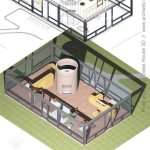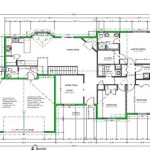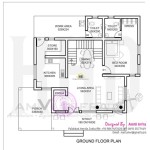Mid-Century Modern Guest House Plans: A Comprehensive Guide
Mid-Century Modern (MCM) architecture, a style that flourished roughly from the mid-1940s to the 1960s, continues to resonate with contemporary design sensibilities. Its clean lines, integration with nature, and functional layouts make it particularly well-suited for guest house designs. This article explores the core principles of MCM architecture as applied to guest house plans, offering a guide to designing or renovating a guest house that embodies this iconic style.
The enduring appeal of MCM lies in its simplicity and practicality. After the Second World War, a renewed emphasis on accessible design influenced architectural trends. Architects sought to create homes that were functional, affordable, and aesthetically pleasing, moving away from the ornamentation of earlier styles. The emphasis shifted towards open floor plans, large windows to maximize natural light, and the use of new materials such as plywood, glass, and steel.
When considering MCM guest house plans, it's crucial to understand the key characteristics that define the style. These elements can be adapted and incorporated into a variety of designs, from small detached studios to larger, fully equipped guest residences.
Key Characteristics of Mid-Century Modern Architecture for Guest Houses
Several design principles are fundamental to achieving a successful Mid-Century Modern guest house. These principles not only define the aesthetic but also contribute to the functionality and livability of the space.
1. Integration with Nature: One of the most distinctive features of MCM design is its strong connection to the outdoors. Large windows, sliding glass doors, and patios are used to blur the lines between interior and exterior spaces. When designing a guest house, consider its orientation in relation to the surrounding landscape. Maximizing views, providing easy access to outdoor areas, and using natural materials like wood and stone can enhance the feeling of connection to nature.
Consider the landscaping surrounding the guest house. MCM landscaping often features minimalist gardens with native plants, gravel pathways, and strategically placed rocks. Avoid overly manicured lawns and formal flower beds. Instead, opt for a more naturalistic approach that complements the architecture.
2. Open Floor Plans and Functional Layouts: MCM architecture favors open and flexible spaces. In a guest house, this can translate to a combined living, dining, and kitchen area, creating a sense of spaciousness even in a smaller footprint. Carefully consider the flow of traffic within the guest house. Ensure that the layout is intuitive and that each area is easily accessible. Incorporate built-in storage solutions to maximize space and minimize clutter.
The integration of indoor and outdoor spaces through open floor plans also emphasizes the social aspect of the guest house. Guests can easily interact with the surrounding environment and feel connected to the main house, while still having their own private retreat. The functional layout also caters to a variety of activities, allowing guests to relax, work, or entertain.
3. Geometric Forms and Clean Lines: MCM architecture is characterized by its simple geometric forms and clean, horizontal lines. Avoid elaborate ornamentation and decorative details. Instead, focus on creating a streamlined and uncluttered design. The roofline is often low-pitched or flat, and the overall structure is typically rectangular or square.
Pay attention to the proportions of the guest house. The goal is to create a balanced and harmonious composition. Use strong horizontal lines to visually ground the structure and to emphasize its connection to the landscape. Incorporate geometric shapes in the windows, doors, and other architectural details.
4. Materials and Textures: The selection of materials is crucial to achieving an authentic MCM look. Wood, glass, steel, and concrete are commonly used. Natural wood finishes are preferred, and the use of color is often restrained. Consider incorporating exposed brick or concrete walls for added texture and visual interest.
When selecting interior finishes, opt for materials that are durable and easy to maintain. Hardwood floors, terrazzo tiles, and simple ceramic tiles are all appropriate choices. Avoid overly ornate or fussy materials. The focus should be on clean lines and functional design.
5. Lighting: Lighting plays a critical role in creating the atmosphere of a Mid-Century Modern guest house. Maximize natural light by incorporating large windows and skylights. Use artificial lighting to complement the natural light and to create a warm and inviting ambiance. Consider using pendant lights, sconces, and recessed lighting to create layers of illumination.
Choose lighting fixtures that are consistent with the MCM aesthetic. Look for fixtures with simple geometric shapes and clean lines. Avoid overly ornate or decorative fixtures. The goal is to create a lighting scheme that is both functional and aesthetically pleasing.
Essential Elements of Mid-Century Modern Guest House Plans
Beyond the overall aesthetic principles, specific elements are crucial to include in your Mid-Century Modern guest house plans to ensure functionality and comfort.
1. Privacy and Soundproofing: While integration with nature is key, ensuring privacy for guests is equally important. Consider the placement of windows and doors to minimize visibility from the main house or neighboring properties. Employ landscaping techniques, such as hedges or trees, to create natural screens. Soundproofing is also essential, particularly if the guest house is located close to a road or other sources of noise. Use sound-dampening materials in the walls, floors, and ceilings to create a peaceful and quiet environment.
Strategic placement of the sleeping area is also crucial for privacy. Consider incorporating a separate bedroom with a solid door to ensure that guests have a private retreat where they can relax and sleep undisturbed.
2. Functional Kitchenette or Full Kitchen: The size and configuration of the kitchen area will depend on the intended use of the guest house. A simple kitchenette with a sink, refrigerator, and microwave may be sufficient for occasional guests. However, if the guest house is intended for longer stays or for guests who prefer to cook their own meals, a full kitchen with a stove, oven, and dishwasher is essential. Consider incorporating elements like open shelving or a breakfast bar to maintain the MCM aesthetic. Proper ventilation is crucial to prevent odors and moisture buildup. Include a range hood above the stove and ensure adequate airflow throughout the kitchen area.
3. Comfortable Bathroom: The bathroom should be designed with both style and functionality in mind. Use simple, clean lines and incorporate durable materials such as tile or stone. Consider incorporating a walk-in shower instead of a bathtub to save space and to create a more modern look. Ample storage is essential for toiletries and personal items. Good ventilation is also crucial to prevent moisture buildup and mold growth. Include an exhaust fan and ensure adequate airflow throughout the bathroom.
Consider adding a skylight or a frosted glass window to bring natural light into the bathroom while maintaining privacy. Incorporate a simple vanity with clean lines and ample storage. Choose fixtures that are consistent with the MCM aesthetic, such as a wall-mounted faucet and a sleek, minimalist sink.
4. Flexible Living Space: The living space should be designed to be flexible and adaptable to a variety of needs. Consider incorporating modular furniture that can be easily rearranged to create different configurations. Include a comfortable seating area with a sofa, chairs, and a coffee table. Provide ample lighting for reading and other activities. A television or entertainment center can also be included, but should be integrated seamlessly into the overall design.
Consider incorporating a workspace area with a desk and a chair. This can be particularly useful for guests who need to work remotely. Ensure that the workspace area is well-lit and has access to power outlets.
Adaptability and Modernization of Mid-Century Modern Guest House Plans
While adhering to the core principles of MCM architecture is important, it's also crucial to adapt the design to suit modern needs and preferences. This includes incorporating modern technologies, improving energy efficiency, and ensuring accessibility.
1. Incorporating Technology: Integrate modern technology seamlessly into the design. Consider incorporating smart home features such as smart lighting, thermostats, and security systems. Install high-speed internet access and ensure that there are ample power outlets throughout the guest house. Conceal wiring and cables to maintain a clean and uncluttered aesthetic.
Choose appliances and electronics that are consistent with the MCM aesthetic. Look for appliances with clean lines and minimalist designs. Consider incorporating a hidden television that can be concealed when not in use.
2. Energy Efficiency: Prioritize energy efficiency in the design. Use energy-efficient windows and doors, insulate the walls, floors, and ceilings properly, and install energy-efficient appliances. Consider incorporating passive solar design principles to maximize natural light and heat gain. Install solar panels to generate electricity and reduce your carbon footprint. Use LED lighting throughout the guest house to reduce energy consumption.
Consider incorporating a rainwater harvesting system to collect rainwater for irrigation and other non-potable uses. Install a low-flow toilet and showerhead to conserve water.
3. Accessibility: Design the guest house to be accessible to people of all ages and abilities. Consider incorporating features such as a ramp or a zero-threshold entry, wider doorways, and grab bars in the bathroom. Ensure that the layout is easy to navigate and that there are no tripping hazards. Provide ample lighting and ensure that all controls are within easy reach.
Consider incorporating a roll-in shower and a height-adjustable sink in the bathroom. Install lever handles on doors and faucets for easier operation. Provide clear signage with large, easy-to-read lettering.
By carefully considering these factors, you can create a Mid-Century Modern guest house that is both stylish and functional, providing a comfortable and welcoming retreat for your guests while adhering to the architectural principles that define this timeless design style.

Mid Century Modern House Plans Houseplans Blog Com

Mid Century Modern House Plans Houseplans Blog Com

Mid Century Modern House Plans Houseplans Blog Com

Mid Century Modern House Plans Houseplans Blog Com

Build A House With These Mid Century Modern Floor Plans Blog Eplans Com

Guest House Plans Truoba Architects

Build A House With These Mid Century Modern Floor Plans Blog Eplans Com

Mid Century Modern House Plans Houseplans Blog Com

Mid Century Modern House Plans Houseplans Blog Com

Build A House With These Mid Century Modern Floor Plans Blog Eplans Com








